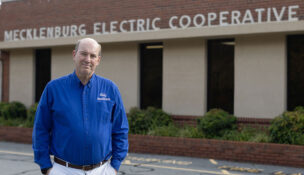Executive insights
Virginia maritime leaders offer thoughts on industry
Executive insights
Virginia maritime leaders offer thoughts on industry
Leaders from Virginia’s maritime sector share their thoughts about building a workforce pipeline in Virginia, the growth of offshore wind and how climate change impacts the industry.

JUDY BARRETT
Virginia Maritime Association board president; TowneBank private banking officer; Norfolk
VB: As president of VMA’s board, what’s your main priority this year?
Barrett: My main priority is to advance the initiatives that the VMA has set forth. The VMA serves over 450 companies in different sectors of the maritime industry, such as importers and exporters, ship operators, ship repairers, offshore wind interests, trucking and warehousing, tugboats, and so much more. We are in the process of implementing and executing our updated five-year strategic plan, which includes enhancing services and activities that help our member companies grow their business.
VB: What is most important to consider in building and sustaining a maritime workforce pipeline in Virginia?
Barrett: Workforce development is a large focus as we are preparing for the next generations to continue advancing our maritime industry. We need to make sure educators and students in middle and high schools are aware of the different jobs available. We also need to make certain our graduates can gain employment in the maritime and supply chain industries and stay to work in Virginia.
VB: How do the maritime association and port work together for industry success?
Barrett: While VMA works behind the scenes with their numerous committees to make things happen, the port is keeping commerce flowing. We are so fortunate to have such collaborative participation in this industry.

ARKETA HOWARD
Virginia Maritime Association board member; director of business and policy affairs in offshore wind, Crowley Maritime Corp.; Norfolk
VB: What is your main goal for the VMA?
Howard: My main goal as a VMA member is to ensure the association’s success, which includes efforts around advocacy for maritime and offshore wind, supporting maritime-focused educational partnerships, informing the business community about the resources and services of the VMA, and making connections between our members, the maritime and offshore wind community and supply chain. Maritime fuels Virginia’s economy, and the VMA plays an essential role in supporting its success.
VB: How does Virginia compare with other states in developing the offshore wind industry? How likely is it that Virginia will become an offshore-wind supply chain hub?
Howard: Through my national work with Crowley, I have come to appreciate and lean on the strength of each state to carry out our business strategy, feeding into the national goal of deploying 30 gigawatts of offshore wind by 2030.
Virginia has a great start, thanks to our educational, workforce and economic development partners working hand-in-hand to identify funding and other resources to ensure the workforce is aware of the various roles in offshore wind and has access to Global Wind Organisation certification, as well as developing training programs and curriculums to create a robust pipeline that can feed the various facets of offshore wind.
Virginia is also home to America’s largest shipbuilding industry, a deep-rooted maritime business community, informed legislators and government, a high-quality maritime workforce — incomparable to any other state on the East Coast — as well as unobstructed waterfront land and infrastructure, and a well-established port presence with the Port of Virginia.
All are factors establishing Virginia with the baseline needed to serve as a supply chain hub for the offshore wind industry and to explore supporting the construction of floating offshore wind farms along the East Coast in the near future.

THOMAS S. BERKLEY
Shareholder and maritime lawyer, Pender & Coward PC; Virginia Beach
VB: What is your outlook for Hampton Roads’ maritime industry this year?
Berkley: The Port of Virginia set records last year, and 2023 will be even better: Dredging Norfolk’s channels to 55 feet, expanding rail capacity, modernizing the North Berth at Norfolk International Terminals, offshore wind turbines, a corporate wind farm campus at the former Portsmouth Maritime Terminal — these initiatives boost our already thriving port.
VB: What do you expect will be the most important issues facing the maritime industry in five years?
Berkley: Ships and shipyards face pressure to reduce emissions of global warming gases. Environmental regulatory agencies want new forms of compensation when dredging waters with depths 6 feet or less. No part of the maritime industry will escape the costs of these environmental initiatives.
VB: What upcoming maritime legislation should industry executives be keeping an eye on?
Berkley: Congress enacts Water Resources Development Acts (WRDAs) on a biennial basis, most recently in December 2022. As the authorizing legislation for the Army Corps of Engineers’ civil works program, it shapes our nation’s water infrastructure with profound implications for our ports. The 2024 WRDA bill is in the works on Capitol Hill.
VB: We’ve heard about labor shortages causing supply chain delays at other U.S. ports. What is Virginia doing to prevent these problems?
Berkley: Virginia wants to create the Department of Workforce Development and Advancement to improve its workforce development programs. Budget resources are coming for the Virginia Talent Accelerator Program (which helps companies locating or expanding in Virginia), the GO Virginia Talent Pathways program and GO Virginia workforce funding (which stimulates workforce-related collaboration and builds talent pipelines).
t
















